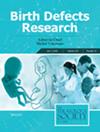Sequencing Analysis Demonstrates That a Complex Genetic Architecture Contributes to Risk for Spina Bifida
Abstract
Background
Spina bifida (SB), a common neural tube defects (NTDs), has a complex genetic architecture that remains incompletely understood. Although prior studies have identified rare, deleterious single nucleotide variants (SNVs) in SB, broader contributions to risk remain unclear. Here, we investigated shared genetic risk among 256 SB probands compared with 395 ancestry-matched controls using an unbiased sequencing approach.
Methods
We performed an exome-wide association study (ExWAS) of 46,887 SNVs with minor allele frequencies (MAF) > 0.001 to identify single-variant associations, followed by gene-based burden tests to assess the cumulative effect of SNVs within genes, using all variants and then restricting to rare variants (MAF < 0.05). Both burden tests were repeated in 510 unaffected parents to evaluate excess mutational burden relative to controls.
Results
Across all analyses, 16 genes were associated with SB: SRCIN1, PDE4DIP, XCL2, CTAGE10P, GLB1L3, PMS2P4, HSPA4, GLB1L2, FAM90A1, PLA1A, HLA-A, SPIRE2, TVP23B, CHD5, FOXA2, and PIF1. ExWAS identified 11 significant SNVs, nine of which were common (MAF > 0.05). The unrestricted burden test identified seven genes; four remained significant when restricted to rare variants, and two additional genes emerged only in that subset. Five burden-associated genes were not detected in the ExWAS, suggesting cumulative variant effects. Four burden-associated genes also showed enrichment in parents, supporting inherited risk. Three of these showed suggestive transmission disequilibrium (p values ≤ 0.10) and one was attributed to multiple SNVs.
Conclusion
These results provide new insight into the multifactorial genetic landscape of SB and highlight the importance of unbiased approaches in constructing genetic models of NTD.


 求助内容:
求助内容: 应助结果提醒方式:
应助结果提醒方式:


